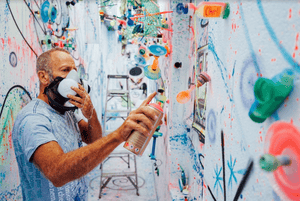“We strongly feel that only Sanders represents the values and virtues which all of us as cultural producers have always hoped to strive for,” the letter reads.
Democratic presidential candidate Bernie Sanders (Gage Skidmore/Flickr)
Nan Goldin, Kara Walker, and Jim Jarmusch are among 665 artists endorsing the Democratic presidential candidate Bernie Sanders in a new open letter.
The campaign is organized by Artists4Bernie, a group founded by artist Mohammed Salemy, together with curator-writer Jennifer Teets and the collective DIS.
A long list of luminaries has signed the letter including the musicians Sky Ferreira, Kelsey Lu, and M.I.A.; gallerist Margaret Clinton; designers Telfar Clemens, Mike Eckhaus, Zoe Latta; and the artists Lawrence Abu Hamdan, Ed Atkins, Kader Attia, Kevin Beasley, Hannah Black, Ryan McGinley, Hito Steyerl, Wu Tsang, Amalia Ulman, Leilah Weinraub, and Anicka Yi, among many others.
“By endorsing Bernie Sanders we hope to reach out to our American colleagues, friends, and families, and express our enthusiasm in supporting, and voting for, the only candidate we believe can unseat Donald Trump,” the open letter reads.
The letter continues to extol Sanders’s economic, foreign, and environmental policies. It also makes the argument that a Sanders administration would be to the benefit of artists and the cultural sectors at large, declaring:
Bernie Sanders is leading a working class movement that transcends ethnicities, generations, and geographies. Artists and cultural producers are largely precarity laborers–often struggling without benefits, financial security, at the whim of the market. These fields are therefore more inclined to attract people who are already privileged, at the expense of the less privileged—and, often, more talented. Medicare for all, universal childcare, canceling student debt, and free public college, are just a few of the progressive changes that we support for their soundness and logic, that will spill over into a more equal cultural sphere.
“Overall, we strongly feel that only Sanders represents the values and virtues which all of us as cultural producers have always hoped to strive for,” the letter adds and quotes from Sander’s promise to be an “arts President”.
“We believe that a Sanders presidency will provide a serious and tangible chance for a redirection of the United States and perhaps the entire world from the wrong paths that have been followed for far too long,” the letter closes. “President Sanders will inaugurate a new era for America: one of peace, prosperity, and essential human dignity.”
'We were all a little bit punk': Haring, Basquiat and the art that defined 80s New York
New York critic and curator Carlo McCormick picks the 10 pieces that cemented the radical legacy of a game-changing art scene

Carlo McCormick, art critic in front of Keith Haring’s Malcolm X, 1988, on show at the National Gallery of Victoria. Photograph: Tim Carrafa
New York curator and cultural critic Carlo McCormick is proud and serene as he describes the National Gallery of Victoria’s blockbuster 2020 exhibition, Crossing Lines, as a “celebration”. He’s also quick to note that this is not just a celebration of the men whose names are on the door.
“Keith [Haring] and Jean-Michel [Basquiat] are really ciphers that signify a whole group of artists and community,” says McCormick, who guest curated the show. “Every bit of modernism was actually a gang of friends getting together.” And there’s no arguing that this gang – “a bunch of bratty kids” – defined an era.
Jean-Michel Basquiat, Keith Haring and New York in the 1980s – in pictures
“At that time, museums were very insular,” McCormick says. “They were for blue-haired old ladies ... And there was a whole group of narcissistic white men who thought they knew better. They looked down on us.”
Haring, and Basquiat defied this. Coming from marginalised communities – Haring was gay, Basquiat was black – they made vibrant and often political art that was “vernacular and younger and more youth-oriented”, and then they made that kind of art the norm.
McCormick discussed with the Guardian 10 works (and the people behind them) that cemented this radical legacy – three of which are currently on show at the NGV.
‘It was knowing that, at any moment, our world could blow up’: Keith Haring Untitled 1982. Photograph: Keith Haring Foundation
Whether on subway walls, scraps of paper or large industrial tarps (like this piece), Keith Haring’s work “was meant to be universal”. The young artist developed an iconic visual language of simple motifs – dogs, babies, hearts – and used them to communicate his generation’s not-so-simple energy and anxieties.
Jean-Michel Basquiat’s Hollywood Africans in front of the Chinese Theatre with footprints of movie stars, 1983. Photograph: Pace Editions/National Gallery of Victoria, Melbourne
Jean-Michel Basquiat rocketed to fame in his late teens and early twenties. Within a few years, the Brooklyn-born artist of Haitan and Puerto Rican descent went from doing local graffiti under a pseudonym, to exhibiting at the country’s best galleries.
“This work is at a moment when [he’s] getting bigger,” McCormick says. In the work, which is currently hung at the NGV, Basquiat is depicted (on the right) with fellow black artists Toxic and Rammellzee. “They’re living large, but there’s a lot of tragedy built into their success.
“It’s kind of a tribute to his fellow black people in the art world [and a] barbed joke. African Americans were not well represented in our cinema, and if they were they were caricatured and marginalised. It was sort of a way of saying, ‘Hey, we’re the Hollywood Africans. It’s the same deal: we’re playing like blackface for white people.’”
This was an era in which art became enmeshed with celebrity – and while that meant young artists like Basqiaut could prosper, it also ensured their work was seen as “spectacle”, rather than art. “It was given the same degree of analysis that we might give a K-pop star today,” McCormick says. That degree of analysis has certainly changed since the artist’s death from overdose, at age 27 in 1988.
Pile of crowns for Jean-Michel Basquiat - Keith Haring

Gil Vazquez, president of the Keith Haring Foundation, in front of Pile of Crowns for Jean-Michel Basquiat, at the NGV exhibition Crossing Lines. Photograph: Graham Denholm/Getty Images for NGV
“Keith really loved Jean-Michel,” McCormick says. “It’s a memorial. Think of the momento mori in Renaissance paintings; the reminder of death.” The crown was Basquiat’s most iconic symbol, used frequently in his work.
“[They] had this incredible mutual respect,” he adds. “They had much in common, generationally and in terms of [being outsiders] … All these people came [downtown] because they were different. They were ostracised and alienated from this ‘normal America’.”
This era of artists met and bonded on the street and in the nightclubs. “People liked to dance,” McCormick reminisces. “Now, maybe Jackson Pollock liked to dance, but I’m sure he danced like the ugliest white guy on the planet. This was a generation that had the beat, it had the rhythm.”
This work came at a time of great change, in the midst of the Aids crisis. “We went from partying every night to going to memorial services every week,” McCormick says. He notes a “tremendous gravitas” in this; they are aware of a moment passing. “[It’s] the way that spring is fun, but fall is something else because you feel winter coming on.”
‘Keith really loved Jean-Michel,’ says curator Carlo McCormick. Photograph: Keith Haring Foundation
Vivienne Westwood’s Witches collection (83-84)
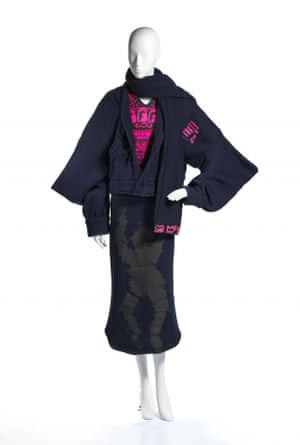
Outfit by Vivienne Westwood and Malcolm McLaren from Witches collection (1983-4). Photograph: National Gallery of Victoria, Melbourne
Yes, Vivienne Westwood is British. But her iconic punk aesthetic had a lasting impact in the US and McCormick argues it actually had its origins in New York. “I hate to be such a provincial New Yorker, but before [Westwood’s collaborator Malcolm McLaren] created the Sex Pistols as his little boy band, he managed the New York Dolls ... Malcolm was very influenced by what was going on in New York”.
By the 80s, he recalls, “we were all a little bit punk – even if some people were into dance music, others were into hip hop … There was this hybridity, and fashion was very much interspersed in our culture.”
“Keith [whose work was featured in the Witches collection] cared very much about the ability for his art to interact with the real world – the day-to-day.” This continues today, with his work most accessible on T-shirts and fridge magnets.
Self-portrait no 9 - Andy Warhol
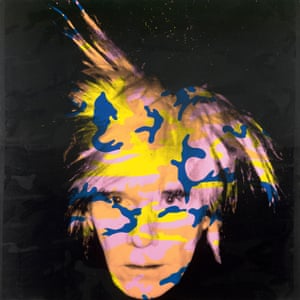
Andy Warhol’s Self Portrait no.9 (1986). Photograph: Andy Warhol/ARS, New York/National Gallery of Victoria
People forget, McCormick says, that Andy Warhol was at “the total nadir” of his career in the 80s.
“He was very uncool. [But] what really brought him back was the fact that there was this whole generation – me included – who adored him. Many of us had moved to New York because of the Factory and Warhol’s books.”
Two decades on from his seminal work in the pop art movement, Warhol became something of a mentor to artists like Haring and Basquiat. “Everyone talks about how he was a little vampiric in his relationship to people, but he was very generous and very supportive. There was a beautiful connectivity – an intergenerational conversation.”
In this portrait, one year before his death, Warhol renders himself with the same pop art methods that inspired others. “He had a particular way about reaching people,” McCormick says. “About how you can do signifiers without being didactic, and how personality and life can become part of the art”. “Also,” he adds, “Andy queered things up”.
The midnight sun - Francesco Clemente
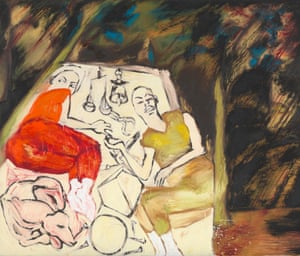
‘He was just an incredible painter’: Francesco Clemente’s The Midnight Sun XII (1982). Photograph: Christian Markel/National Gallery of Victoria
Francesco Clemente migrated from Italy to join the scene in New York. He wasn’t the nightclub type – “less Mudd Club, more like Mr Chow’s”, McCormick says – and his work had a different energy to it. It was all pastels and soft edges.
“Clemente had been going to India since the ‘70s and he brought in much more poetic, much more Italian, a little more mythical, allegorical [influences]. But he was also just an incredible painter. Great painters recognise great painters as something entirely distinct from all the people who don’t push paint in such a magical way.”
Clemente and Basquiat are also often lumped together as neo-expressionists; whether you agree with that label or not, it’s true that they defined an era of raw and emotive art. This then went “out of favour” towards the end of the ‘80s with the rise of neo-geo (think Jeff Koons) which was “much more about intellectualising your emotions”.
Alistair Butler - Robert Mapplethorpe
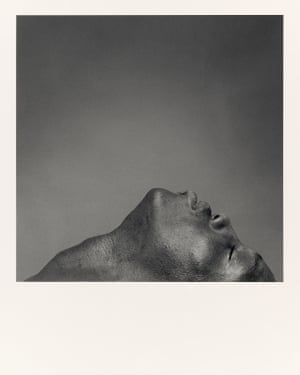
Robert Mapplethorpe’s photograph of Alistair Butler (1980) is ‘an ecstatic thing’. Photograph: National Gallery of Victoria, Melbourne
“This is an ecstatic thing,” McCormick says. “If it’s not a photo of an orgasm, it’s one to bring you towards that ecstatic state.” It might sound provocative, but when seen in the context of Robert Mapplethorpe’s broader work it’s just a statement of fact.
Maybe Jackson Pollock liked to dance, but I’m sure he danced like the ugliest white guy on the planet…This was a generation that had the beat.
The New York-based photographer had “a wonderful sense of beauty, which was based off ‘the other’,” McCormick says.
“Obviously sexuality and fetish are part of it, but it’s more interesting than that … Beauty had been so codified by then – from Boticelli to the pinup girls in the Hollywood magazines.”
Mapplethorpe portrayed the beauty of people who were “inherently different – by lifestyle or by body”. Alistair Butler, the model used for this work, was a New York dancer originally from the Bahamas. “Haring, Basiquat, all of them, this is a generation of really questioning people – they’re all sponges. They take from everything around them.”
When The Worlds Collide - Kenny Scharf
New York artist Kenny Scharf, a peer and friend of Basquiat and Haring. Photograph: Green Street Agency
Kenny Scharf grew up on the west coast, but met Keith Haring at art school in New York. Like Haring, McCormick says, “his stuff looks so cartoony, happy – really fun. But it’s all candy-coated. It’s a bitter pill”. When The Worlds Collide is another work about nuclear catastrophe: a grotesque and lurid collision of utopia and its demise.
“[This] generation was promised a beautiful future. There was going to be better living through technology ... we were all going to be flying around in space! Instead we’re the punk generation of no future.”
Untitled (We Don’t Need Another Hero) - Barbara Kruger
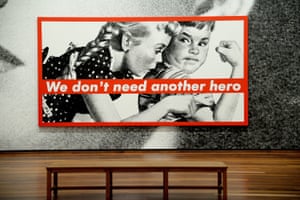
An installation view from a Barbara Kruger art show held at the National Gallery of Art in Washington, DC in September 2016. Photograph: Shannon Finney/Getty Images
Feminist art was fantastic in 1980s New York, McCormick says, but unfortunately “it was just being ignored”. Barbara Kruger was the exception: the graphic designer-turned-artist became known for her acid-tongued text works that took aim at consumerism, the patriarchy and the intersection of the two.
“She took the seductive language of advertising and consumerism, to throw it back in a way that rips it apart,” McCormick says. “Pop art took popular culture in a kinda acquiescent way, without really questioning so much – it’s just a Brillo box – [but she used it] to subvert and to question.”
In this work, the images are taken from 1950s advertising: the boy’s posture is reminiscent of Rosie the Riveter, and the title is a Tina Turner song from two years prior. Kruger led the way for dense, appropriation-fuelled art while “profoundly speaking to the women’s condition from [the New York] scene”.
Video Flag Z - Nam June Paik

Video artist Nam June Paik with his video sculpture Fin de Siecle II. Photograph: Mario Ruiz/The LIFE Images Collection via Getty Images
Like Warhol, Nam June Paik was a “forefather figure” in the 80s scene. Paik grew up in Korea and moved to New York in the 1960s where, McCormick says, he became “one of the seminal figures of Fluxus – with Yoko Ono and all sorts of interesting people”. It was another “gang of friends getting together” that, in fact, had much in common with Haring, Basquait and co.
Fluxus wanted to playfully destroy the boundaries between “art” and “life”, and experiment with the nature of what art could be. The movement was also fiercely anti-consumerist and, for Paik, this was most evident in his work relating to television. “I remember his first video was like the earliest TV you could imagine, just a video of the moon, called Moon Is The Oldest TV,” McCormick recalls.
In the MTV generation of the 80s, Paik went on to become “the father of video art”. In Video Flag Z, he “reconstituted American identity as a Korean living in America”. He may not have been a “bratty kid” but, like Basquait, Paik had a perspective so few others in the white art world could offer.
• NGV’s Keith Haring | Jean-Michel Basquiat: Crossing Lines is showing in Melbourne until 11 April 2020
• The Stories of a Scene series is supported by the National Gallery of Victoria











